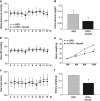Role of mineralocorticoid receptor/Rho/Rho-kinase pathway in obesity-related renal injury
- PMID: 22184057
- PMCID: PMC3419977
- DOI: 10.1038/ijo.2011.232
Role of mineralocorticoid receptor/Rho/Rho-kinase pathway in obesity-related renal injury
Abstract
Objective: We examined whether aldosterone/Rho/Rho-kinase pathway contributed to obesity-associated nephropathy.
Subjects: C57BL/6J mice were fed a high fat or low fat diet, and mice on a high fat diet were treated with a mineralocorticoid receptor antagonist, eplerenone.
Results: The mice on a high fat diet not only developed obesity, but also manifested renal histological changes, including glomerular hypercellularity and increased mesangial matrix, which paralleled the increase in albuminuria. Furthermore, enhanced Rho-kinase activity was noted in kidneys from high fat diet-fed mice, as well as increased expressions of inflammatory chemokines. All of these changes were attenuated by eplerenone. In high fat diet-fed mice, mineralocorticoid receptor protein levels in the nuclear fraction and SGK1, an effector of aldosterone, were upregulated in kidneys, although serum aldosterone levels were unaltered. Furthermore, aldosterone and 3β-hydroxysteroid dehydrogenase in renal tissues were upregulated in high fat diet-fed mice. Finally, in cultured mesangial cells, stimulation with aldosterone enhanced Rho-kinase activity, and pre-incubation with eplerenone prevented the aldosterone-induced activation of Rho kinase.
Conclusion: Excess fat intake causes obesity and renal injury in C57BL/6J mice, and these changes are mediated by an enhanced mineralocorticoid receptor/Rho/Rho-kinase pathway and inflammatory process. Mineralocorticoid receptor activation in the kidney tissue and the subsequent Rho-kinase stimulation are likely to participate in the development of obesity-associated nephropathy without elevation in serum aldosterone levels.
Figures






Similar articles
-
Endothelial mineralocorticoid receptor activation mediates endothelial dysfunction in diet-induced obesity.Eur Heart J. 2013 Dec;34(45):3515-24. doi: 10.1093/eurheartj/eht095. Epub 2013 Apr 17. Eur Heart J. 2013. PMID: 23594590 Free PMC article.
-
Role of Rho kinase and oxidative stress in cardiac fibrosis induced by aldosterone and salt in angiotensin type 1a receptor knockout mice.Regul Pept. 2010 Feb 25;160(1-3):133-9. doi: 10.1016/j.regpep.2009.12.002. Epub 2009 Dec 5. Regul Pept. 2010. PMID: 19969025
-
Rho kinase pathway is likely responsible for the profibrotic actions of aldosterone in renal epithelial cells via inducing epithelial-mesenchymal transition and extracellular matrix excretion.Cell Biol Int. 2013 Jul;37(7):725-30. doi: 10.1002/cbin.10082. Epub 2013 Apr 8. Cell Biol Int. 2013. PMID: 23456826
-
Aldosterone stimulates nuclear factor-kappa B activity and transcription of intercellular adhesion molecule-1 and connective tissue growth factor in rat mesangial cells via serum- and glucocorticoid-inducible protein kinase-1.Clin Exp Nephrol. 2012 Feb;16(1):81-8. doi: 10.1007/s10157-011-0498-x. Epub 2011 Nov 1. Clin Exp Nephrol. 2012. PMID: 22042038 Review.
-
Possible underlying mechanisms responsible for aldosterone and mineralocorticoid receptor-dependent renal injury.J Pharmacol Sci. 2008 Dec;108(4):399-405. doi: 10.1254/jphs.08r02cr. Epub 2008 Dec 5. J Pharmacol Sci. 2008. PMID: 19057124 Review.
Cited by
-
Lack of PPARβ/δ-Inactivated SGK-1 Is Implicated in Liver Carcinogenesis.Biomed Res Int. 2020 Oct 2;2020:9563851. doi: 10.1155/2020/9563851. eCollection 2020. Biomed Res Int. 2020. PMID: 33083492 Free PMC article.
-
Renal mineralocorticoid receptor expression is reduced in lipoatrophy.FEBS Open Bio. 2019 Jan 18;9(2):328-334. doi: 10.1002/2211-5463.12579. eCollection 2019 Feb. FEBS Open Bio. 2019. PMID: 30761257 Free PMC article.
-
The interaction between Shroom3 and Rho-kinase is required for neural tube morphogenesis in mice.Biol Open. 2014 Aug 29;3(9):850-60. doi: 10.1242/bio.20147450. Biol Open. 2014. PMID: 25171888 Free PMC article.
-
Circulating aldosterone and natriuretic peptides in the general community: relationship to cardiorenal and metabolic disease.Hypertension. 2015 Jan;65(1):45-53. doi: 10.1161/HYPERTENSIONAHA.114.03936. Epub 2014 Nov 3. Hypertension. 2015. PMID: 25368032 Free PMC article.
-
Animal Fat Intake Is Associated with Albuminuria in Patients with Non-Alcoholic Fatty Liver Disease and Metabolic Syndrome.Nutrients. 2021 May 4;13(5):1548. doi: 10.3390/nu13051548. Nutrients. 2021. PMID: 34064372 Free PMC article.
References
-
- Bagby SP. Obesity-initiated metabolic syndrome and the kidney: a recipe for chronic kidney disease. J Am Soc Nephrol. 2004;15:2775–2791. - PubMed
-
- Henegar JR, Bigler SA, Henegar LK, Tyagi SC, Hall JE. Functional and structural changes in the kidney in the early stages of obesity. J Am Soc Nephrol. 2001;12:1211–1217. - PubMed
-
- Fukata Y, Amano M, Kaibuchi K. Rho-Rho-kinase pathway in smooth muscle contraction and cytoskeletal reorganization of non-muscle cells. Trends Pharmacol Sci. 2001;22:32–39. - PubMed
-
- Kanda T, Wakino S, Hayashi K, Homma K, Ozawa Y, Saruta T. Effect of fasudil on Rho-kinase and nephropathy in subtotally nephrectomized spontaneously hypertensive rats. Kidney Int. 2003;64:2009–2019. - PubMed
-
- Wehrwein EA, Northcott CA, Loberg RD, Watts SW. Rho/Rho kinase and phosphoinositide 3-kinase are parallel pathways in the development of spontaneous arterial tone in deoxycorticosterone acetate-salt hypertension. J Pharmacol Exp Ther. 2004;309:1011–1019. - PubMed
MeSH terms
Substances
LinkOut - more resources
Full Text Sources
Medical

